Promoting Health and Wellbeing in Early Childhood Education and Care
VerifiedAdded on 2023/06/08
|10
|3020
|286
AI Summary
This article discusses the importance of promoting health and wellbeing in early childhood education and care. It covers the role of teachers, curriculum, and partnerships in ensuring children's health and safety. The article also provides strategies for promoting healthy eating habits and maintaining hygiene in children.
Contribute Materials
Your contribution can guide someone’s learning journey. Share your
documents today.
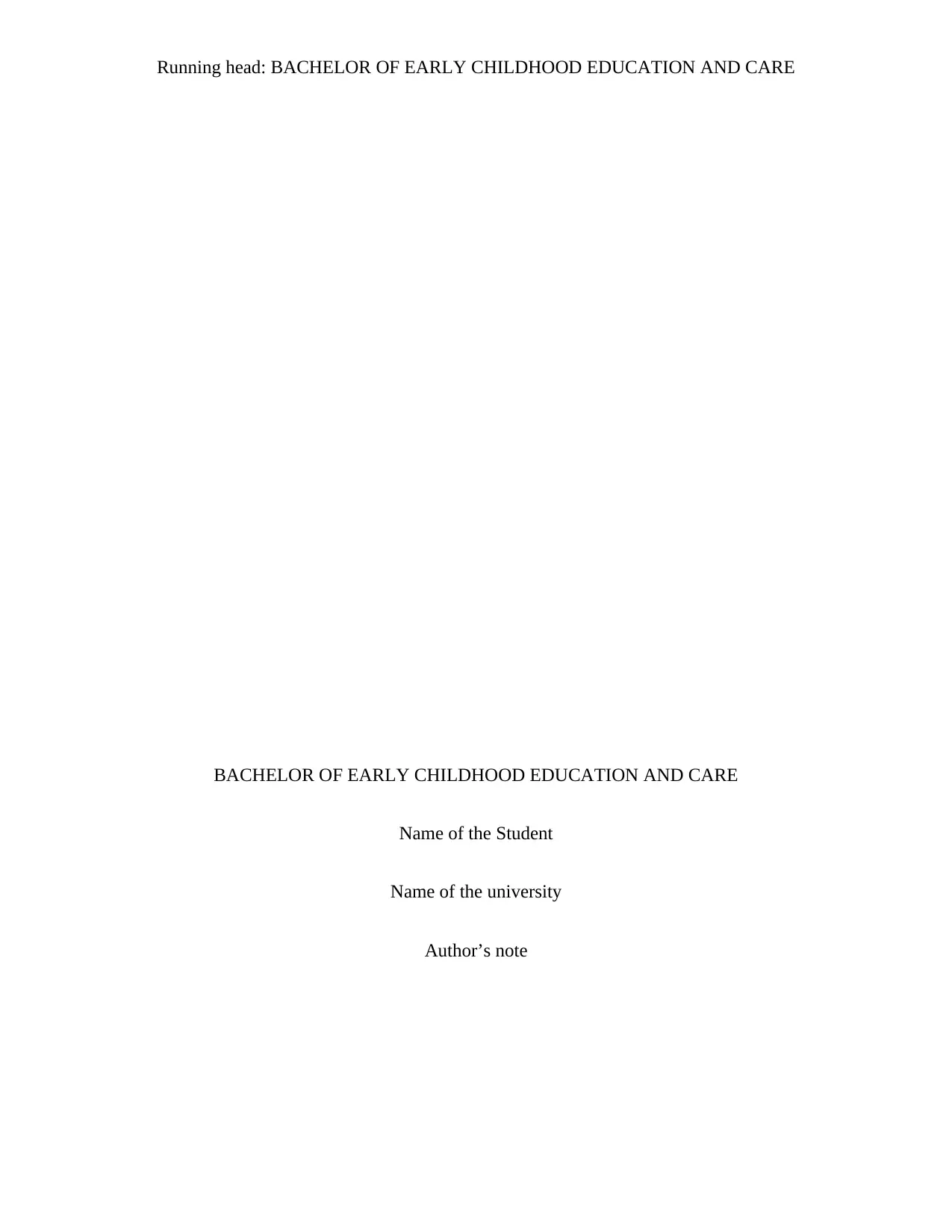
Running head: BACHELOR OF EARLY CHILDHOOD EDUCATION AND CARE
BACHELOR OF EARLY CHILDHOOD EDUCATION AND CARE
Name of the Student
Name of the university
Author’s note
BACHELOR OF EARLY CHILDHOOD EDUCATION AND CARE
Name of the Student
Name of the university
Author’s note
Secure Best Marks with AI Grader
Need help grading? Try our AI Grader for instant feedback on your assignments.
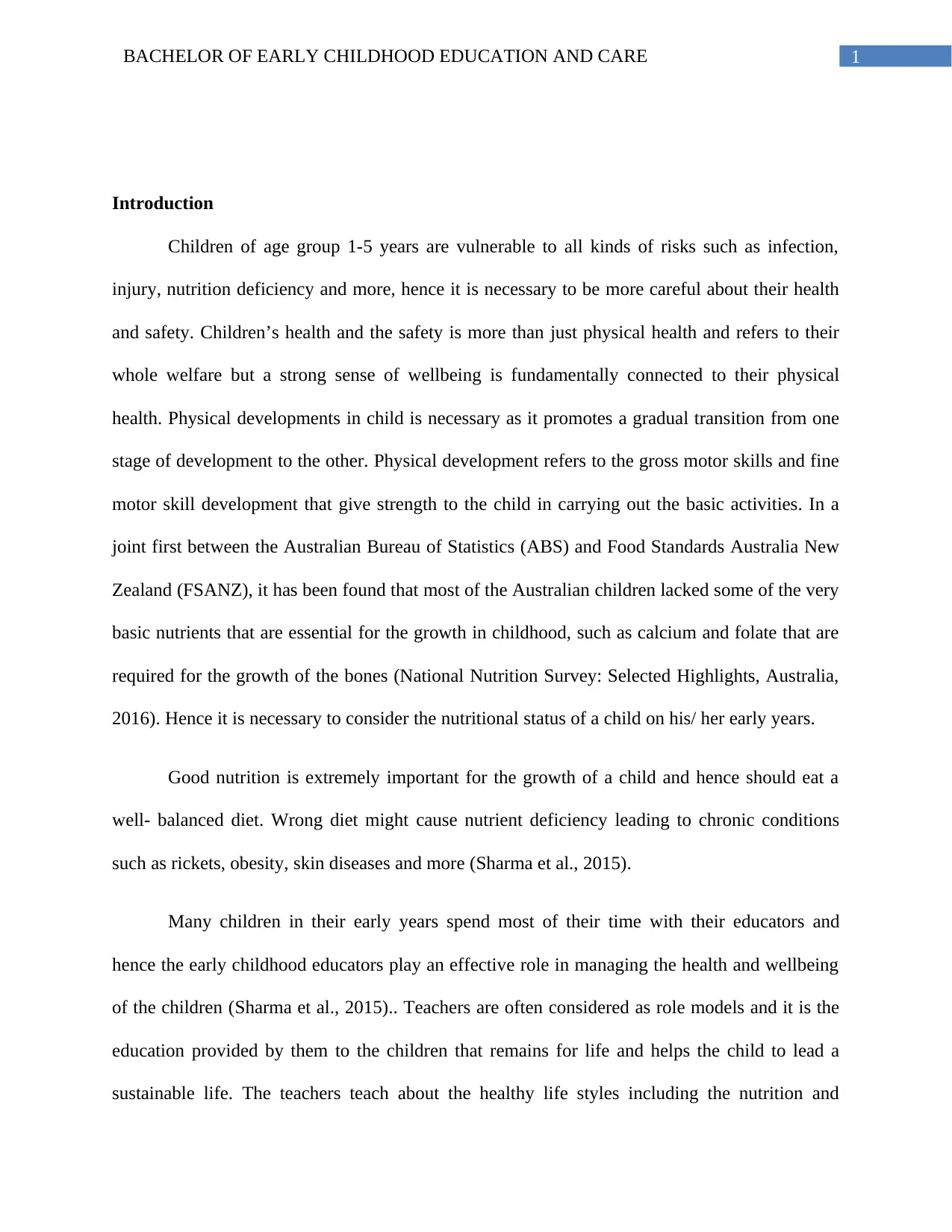
1BACHELOR OF EARLY CHILDHOOD EDUCATION AND CARE
Introduction
Children of age group 1-5 years are vulnerable to all kinds of risks such as infection,
injury, nutrition deficiency and more, hence it is necessary to be more careful about their health
and safety. Children’s health and the safety is more than just physical health and refers to their
whole welfare but a strong sense of wellbeing is fundamentally connected to their physical
health. Physical developments in child is necessary as it promotes a gradual transition from one
stage of development to the other. Physical development refers to the gross motor skills and fine
motor skill development that give strength to the child in carrying out the basic activities. In a
joint first between the Australian Bureau of Statistics (ABS) and Food Standards Australia New
Zealand (FSANZ), it has been found that most of the Australian children lacked some of the very
basic nutrients that are essential for the growth in childhood, such as calcium and folate that are
required for the growth of the bones (National Nutrition Survey: Selected Highlights, Australia,
2016). Hence it is necessary to consider the nutritional status of a child on his/ her early years.
Good nutrition is extremely important for the growth of a child and hence should eat a
well- balanced diet. Wrong diet might cause nutrient deficiency leading to chronic conditions
such as rickets, obesity, skin diseases and more (Sharma et al., 2015).
Many children in their early years spend most of their time with their educators and
hence the early childhood educators play an effective role in managing the health and wellbeing
of the children (Sharma et al., 2015).. Teachers are often considered as role models and it is the
education provided by them to the children that remains for life and helps the child to lead a
sustainable life. The teachers teach about the healthy life styles including the nutrition and
Introduction
Children of age group 1-5 years are vulnerable to all kinds of risks such as infection,
injury, nutrition deficiency and more, hence it is necessary to be more careful about their health
and safety. Children’s health and the safety is more than just physical health and refers to their
whole welfare but a strong sense of wellbeing is fundamentally connected to their physical
health. Physical developments in child is necessary as it promotes a gradual transition from one
stage of development to the other. Physical development refers to the gross motor skills and fine
motor skill development that give strength to the child in carrying out the basic activities. In a
joint first between the Australian Bureau of Statistics (ABS) and Food Standards Australia New
Zealand (FSANZ), it has been found that most of the Australian children lacked some of the very
basic nutrients that are essential for the growth in childhood, such as calcium and folate that are
required for the growth of the bones (National Nutrition Survey: Selected Highlights, Australia,
2016). Hence it is necessary to consider the nutritional status of a child on his/ her early years.
Good nutrition is extremely important for the growth of a child and hence should eat a
well- balanced diet. Wrong diet might cause nutrient deficiency leading to chronic conditions
such as rickets, obesity, skin diseases and more (Sharma et al., 2015).
Many children in their early years spend most of their time with their educators and
hence the early childhood educators play an effective role in managing the health and wellbeing
of the children (Sharma et al., 2015).. Teachers are often considered as role models and it is the
education provided by them to the children that remains for life and helps the child to lead a
sustainable life. The teachers teach about the healthy life styles including the nutrition and
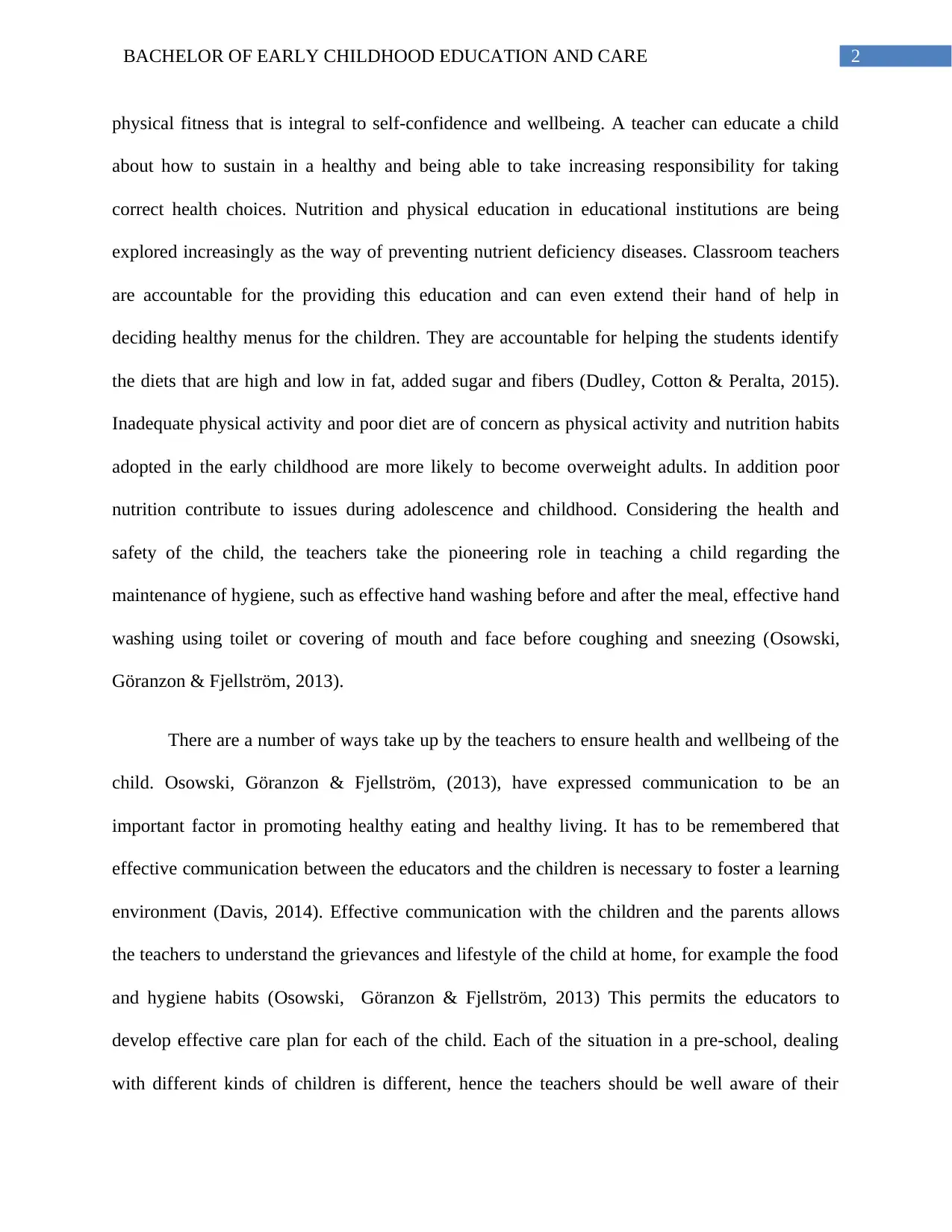
2BACHELOR OF EARLY CHILDHOOD EDUCATION AND CARE
physical fitness that is integral to self-confidence and wellbeing. A teacher can educate a child
about how to sustain in a healthy and being able to take increasing responsibility for taking
correct health choices. Nutrition and physical education in educational institutions are being
explored increasingly as the way of preventing nutrient deficiency diseases. Classroom teachers
are accountable for the providing this education and can even extend their hand of help in
deciding healthy menus for the children. They are accountable for helping the students identify
the diets that are high and low in fat, added sugar and fibers (Dudley, Cotton & Peralta, 2015).
Inadequate physical activity and poor diet are of concern as physical activity and nutrition habits
adopted in the early childhood are more likely to become overweight adults. In addition poor
nutrition contribute to issues during adolescence and childhood. Considering the health and
safety of the child, the teachers take the pioneering role in teaching a child regarding the
maintenance of hygiene, such as effective hand washing before and after the meal, effective hand
washing using toilet or covering of mouth and face before coughing and sneezing (Osowski,
Göranzon & Fjellström, 2013).
There are a number of ways take up by the teachers to ensure health and wellbeing of the
child. Osowski, Göranzon & Fjellström, (2013), have expressed communication to be an
important factor in promoting healthy eating and healthy living. It has to be remembered that
effective communication between the educators and the children is necessary to foster a learning
environment (Davis, 2014). Effective communication with the children and the parents allows
the teachers to understand the grievances and lifestyle of the child at home, for example the food
and hygiene habits (Osowski, Göranzon & Fjellström, 2013) This permits the educators to
develop effective care plan for each of the child. Each of the situation in a pre-school, dealing
with different kinds of children is different, hence the teachers should be well aware of their
physical fitness that is integral to self-confidence and wellbeing. A teacher can educate a child
about how to sustain in a healthy and being able to take increasing responsibility for taking
correct health choices. Nutrition and physical education in educational institutions are being
explored increasingly as the way of preventing nutrient deficiency diseases. Classroom teachers
are accountable for the providing this education and can even extend their hand of help in
deciding healthy menus for the children. They are accountable for helping the students identify
the diets that are high and low in fat, added sugar and fibers (Dudley, Cotton & Peralta, 2015).
Inadequate physical activity and poor diet are of concern as physical activity and nutrition habits
adopted in the early childhood are more likely to become overweight adults. In addition poor
nutrition contribute to issues during adolescence and childhood. Considering the health and
safety of the child, the teachers take the pioneering role in teaching a child regarding the
maintenance of hygiene, such as effective hand washing before and after the meal, effective hand
washing using toilet or covering of mouth and face before coughing and sneezing (Osowski,
Göranzon & Fjellström, 2013).
There are a number of ways take up by the teachers to ensure health and wellbeing of the
child. Osowski, Göranzon & Fjellström, (2013), have expressed communication to be an
important factor in promoting healthy eating and healthy living. It has to be remembered that
effective communication between the educators and the children is necessary to foster a learning
environment (Davis, 2014). Effective communication with the children and the parents allows
the teachers to understand the grievances and lifestyle of the child at home, for example the food
and hygiene habits (Osowski, Göranzon & Fjellström, 2013) This permits the educators to
develop effective care plan for each of the child. Each of the situation in a pre-school, dealing
with different kinds of children is different, hence the teachers should be well aware of their
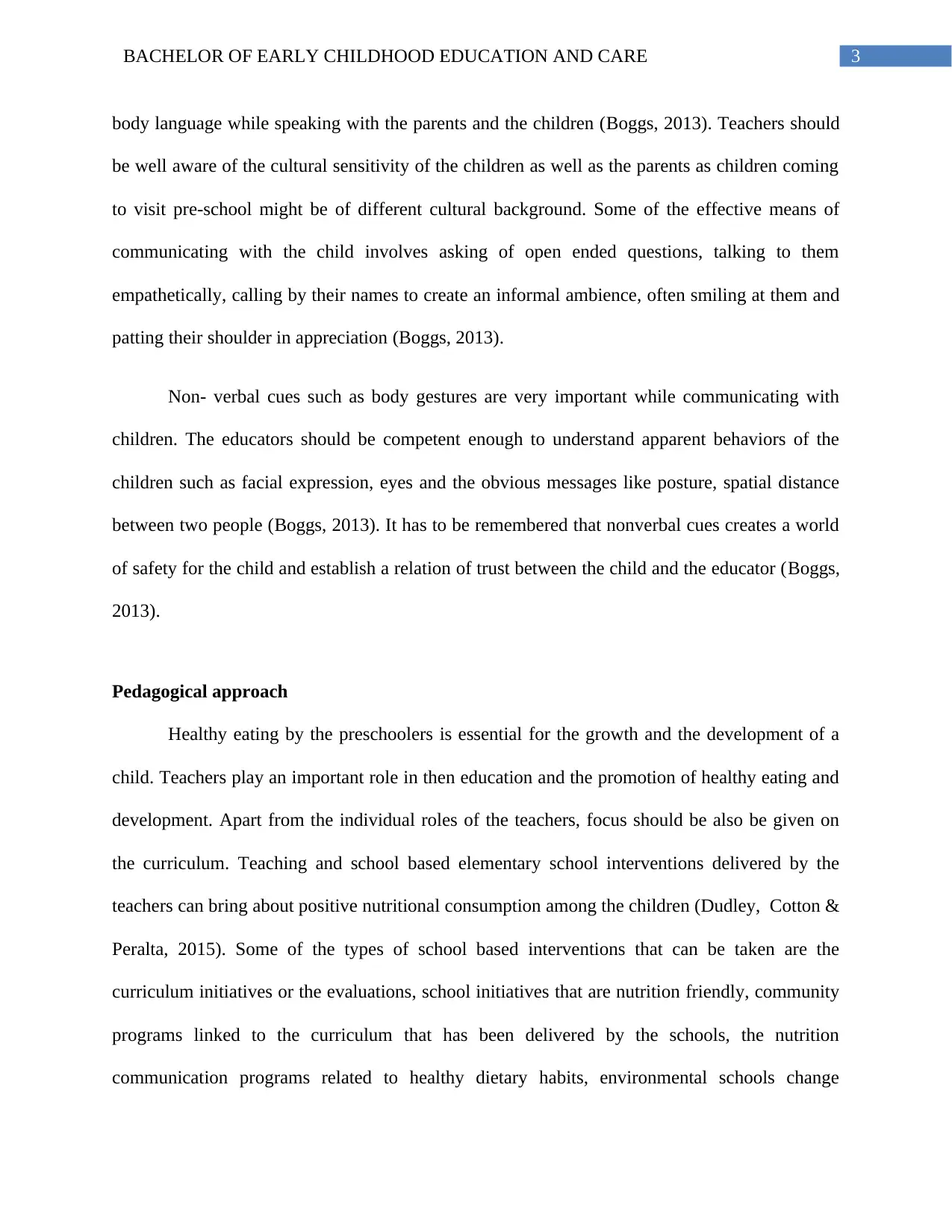
3BACHELOR OF EARLY CHILDHOOD EDUCATION AND CARE
body language while speaking with the parents and the children (Boggs, 2013). Teachers should
be well aware of the cultural sensitivity of the children as well as the parents as children coming
to visit pre-school might be of different cultural background. Some of the effective means of
communicating with the child involves asking of open ended questions, talking to them
empathetically, calling by their names to create an informal ambience, often smiling at them and
patting their shoulder in appreciation (Boggs, 2013).
Non- verbal cues such as body gestures are very important while communicating with
children. The educators should be competent enough to understand apparent behaviors of the
children such as facial expression, eyes and the obvious messages like posture, spatial distance
between two people (Boggs, 2013). It has to be remembered that nonverbal cues creates a world
of safety for the child and establish a relation of trust between the child and the educator (Boggs,
2013).
Pedagogical approach
Healthy eating by the preschoolers is essential for the growth and the development of a
child. Teachers play an important role in then education and the promotion of healthy eating and
development. Apart from the individual roles of the teachers, focus should be also be given on
the curriculum. Teaching and school based elementary school interventions delivered by the
teachers can bring about positive nutritional consumption among the children (Dudley, Cotton &
Peralta, 2015). Some of the types of school based interventions that can be taken are the
curriculum initiatives or the evaluations, school initiatives that are nutrition friendly, community
programs linked to the curriculum that has been delivered by the schools, the nutrition
communication programs related to healthy dietary habits, environmental schools change
body language while speaking with the parents and the children (Boggs, 2013). Teachers should
be well aware of the cultural sensitivity of the children as well as the parents as children coming
to visit pre-school might be of different cultural background. Some of the effective means of
communicating with the child involves asking of open ended questions, talking to them
empathetically, calling by their names to create an informal ambience, often smiling at them and
patting their shoulder in appreciation (Boggs, 2013).
Non- verbal cues such as body gestures are very important while communicating with
children. The educators should be competent enough to understand apparent behaviors of the
children such as facial expression, eyes and the obvious messages like posture, spatial distance
between two people (Boggs, 2013). It has to be remembered that nonverbal cues creates a world
of safety for the child and establish a relation of trust between the child and the educator (Boggs,
2013).
Pedagogical approach
Healthy eating by the preschoolers is essential for the growth and the development of a
child. Teachers play an important role in then education and the promotion of healthy eating and
development. Apart from the individual roles of the teachers, focus should be also be given on
the curriculum. Teaching and school based elementary school interventions delivered by the
teachers can bring about positive nutritional consumption among the children (Dudley, Cotton &
Peralta, 2015). Some of the types of school based interventions that can be taken are the
curriculum initiatives or the evaluations, school initiatives that are nutrition friendly, community
programs linked to the curriculum that has been delivered by the schools, the nutrition
communication programs related to healthy dietary habits, environmental schools change
Secure Best Marks with AI Grader
Need help grading? Try our AI Grader for instant feedback on your assignments.
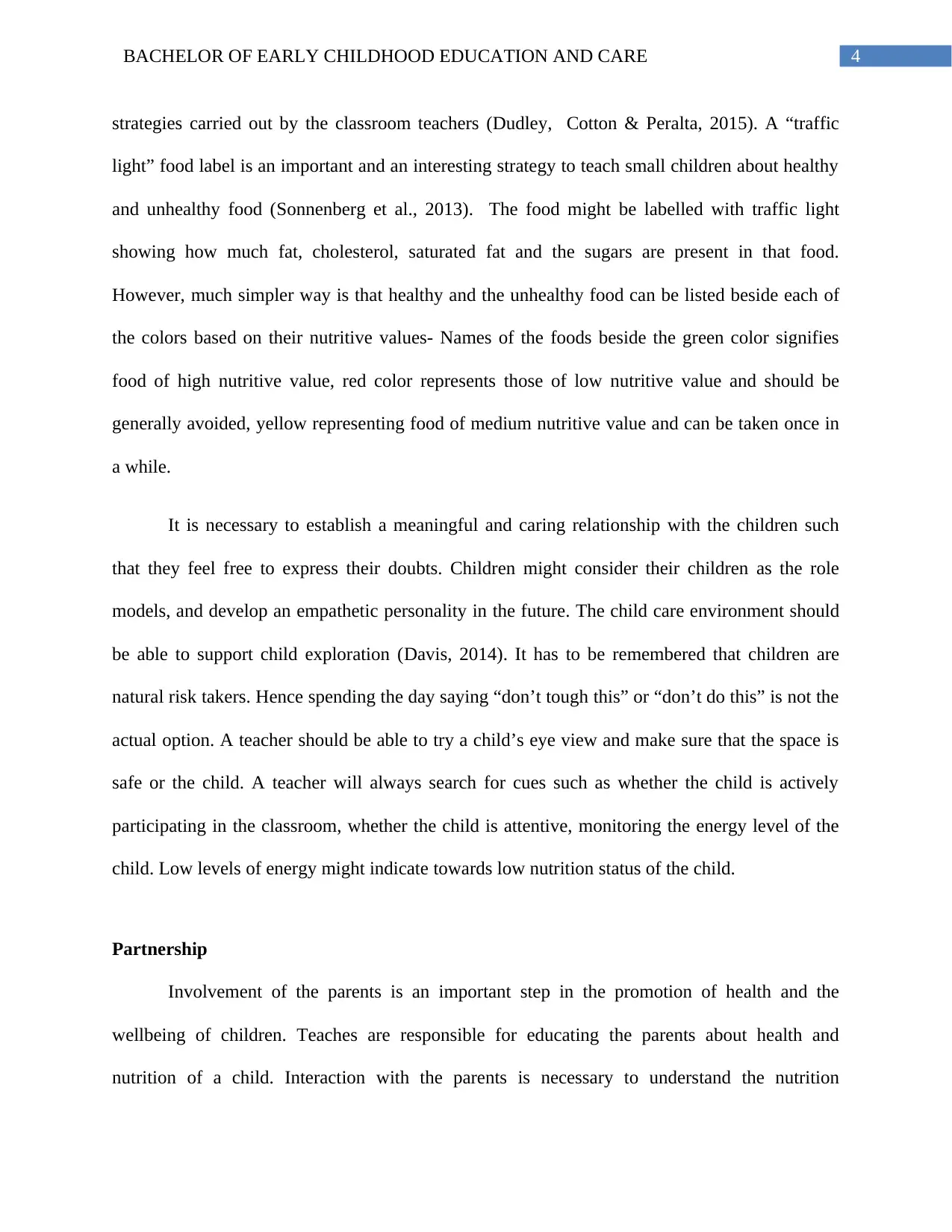
4BACHELOR OF EARLY CHILDHOOD EDUCATION AND CARE
strategies carried out by the classroom teachers (Dudley, Cotton & Peralta, 2015). A “traffic
light” food label is an important and an interesting strategy to teach small children about healthy
and unhealthy food (Sonnenberg et al., 2013). The food might be labelled with traffic light
showing how much fat, cholesterol, saturated fat and the sugars are present in that food.
However, much simpler way is that healthy and the unhealthy food can be listed beside each of
the colors based on their nutritive values- Names of the foods beside the green color signifies
food of high nutritive value, red color represents those of low nutritive value and should be
generally avoided, yellow representing food of medium nutritive value and can be taken once in
a while.
It is necessary to establish a meaningful and caring relationship with the children such
that they feel free to express their doubts. Children might consider their children as the role
models, and develop an empathetic personality in the future. The child care environment should
be able to support child exploration (Davis, 2014). It has to be remembered that children are
natural risk takers. Hence spending the day saying “don’t tough this” or “don’t do this” is not the
actual option. A teacher should be able to try a child’s eye view and make sure that the space is
safe or the child. A teacher will always search for cues such as whether the child is actively
participating in the classroom, whether the child is attentive, monitoring the energy level of the
child. Low levels of energy might indicate towards low nutrition status of the child.
Partnership
Involvement of the parents is an important step in the promotion of health and the
wellbeing of children. Teaches are responsible for educating the parents about health and
nutrition of a child. Interaction with the parents is necessary to understand the nutrition
strategies carried out by the classroom teachers (Dudley, Cotton & Peralta, 2015). A “traffic
light” food label is an important and an interesting strategy to teach small children about healthy
and unhealthy food (Sonnenberg et al., 2013). The food might be labelled with traffic light
showing how much fat, cholesterol, saturated fat and the sugars are present in that food.
However, much simpler way is that healthy and the unhealthy food can be listed beside each of
the colors based on their nutritive values- Names of the foods beside the green color signifies
food of high nutritive value, red color represents those of low nutritive value and should be
generally avoided, yellow representing food of medium nutritive value and can be taken once in
a while.
It is necessary to establish a meaningful and caring relationship with the children such
that they feel free to express their doubts. Children might consider their children as the role
models, and develop an empathetic personality in the future. The child care environment should
be able to support child exploration (Davis, 2014). It has to be remembered that children are
natural risk takers. Hence spending the day saying “don’t tough this” or “don’t do this” is not the
actual option. A teacher should be able to try a child’s eye view and make sure that the space is
safe or the child. A teacher will always search for cues such as whether the child is actively
participating in the classroom, whether the child is attentive, monitoring the energy level of the
child. Low levels of energy might indicate towards low nutrition status of the child.
Partnership
Involvement of the parents is an important step in the promotion of health and the
wellbeing of children. Teaches are responsible for educating the parents about health and
nutrition of a child. Interaction with the parents is necessary to understand the nutrition
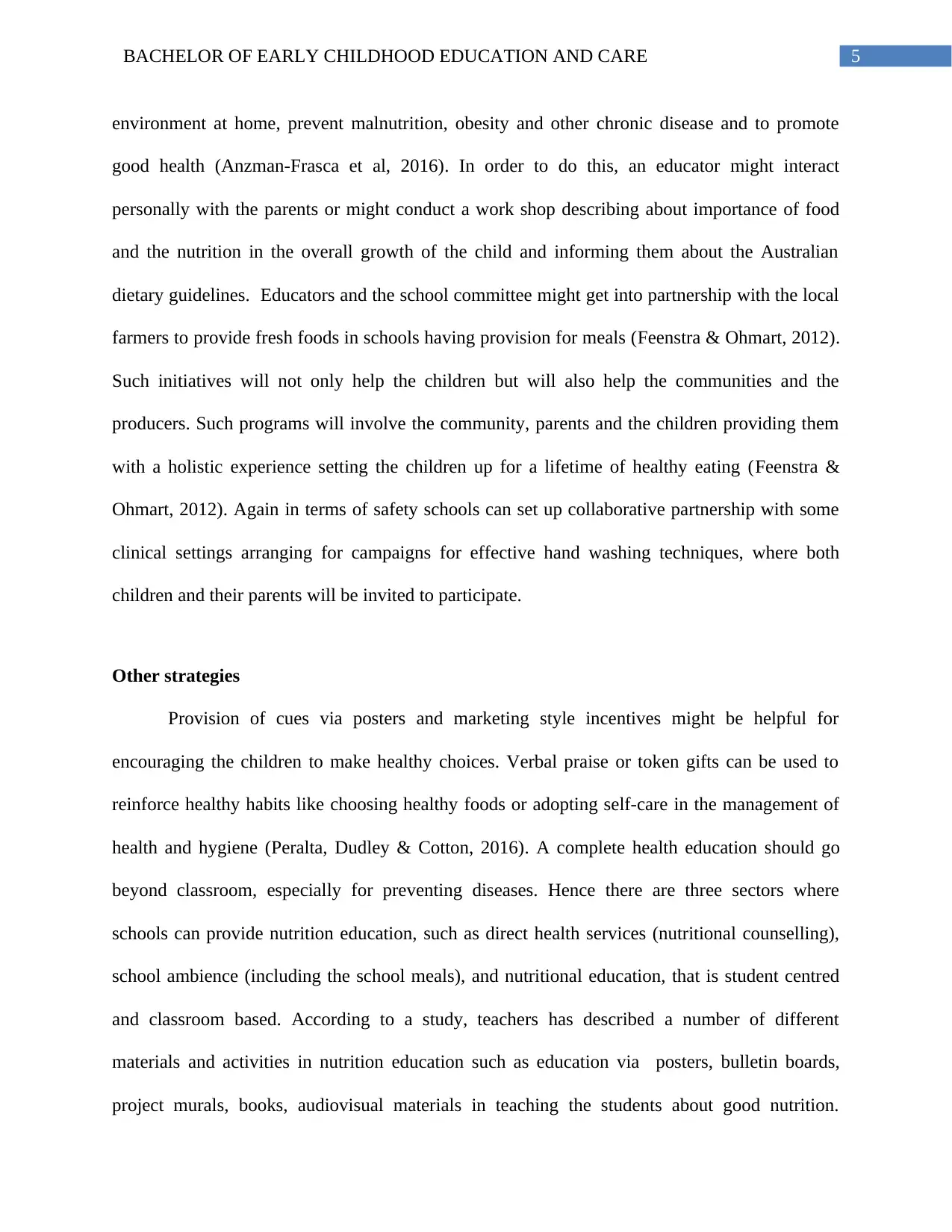
5BACHELOR OF EARLY CHILDHOOD EDUCATION AND CARE
environment at home, prevent malnutrition, obesity and other chronic disease and to promote
good health (Anzman-Frasca et al, 2016). In order to do this, an educator might interact
personally with the parents or might conduct a work shop describing about importance of food
and the nutrition in the overall growth of the child and informing them about the Australian
dietary guidelines. Educators and the school committee might get into partnership with the local
farmers to provide fresh foods in schools having provision for meals (Feenstra & Ohmart, 2012).
Such initiatives will not only help the children but will also help the communities and the
producers. Such programs will involve the community, parents and the children providing them
with a holistic experience setting the children up for a lifetime of healthy eating (Feenstra &
Ohmart, 2012). Again in terms of safety schools can set up collaborative partnership with some
clinical settings arranging for campaigns for effective hand washing techniques, where both
children and their parents will be invited to participate.
Other strategies
Provision of cues via posters and marketing style incentives might be helpful for
encouraging the children to make healthy choices. Verbal praise or token gifts can be used to
reinforce healthy habits like choosing healthy foods or adopting self-care in the management of
health and hygiene (Peralta, Dudley & Cotton, 2016). A complete health education should go
beyond classroom, especially for preventing diseases. Hence there are three sectors where
schools can provide nutrition education, such as direct health services (nutritional counselling),
school ambience (including the school meals), and nutritional education, that is student centred
and classroom based. According to a study, teachers has described a number of different
materials and activities in nutrition education such as education via posters, bulletin boards,
project murals, books, audiovisual materials in teaching the students about good nutrition.
environment at home, prevent malnutrition, obesity and other chronic disease and to promote
good health (Anzman-Frasca et al, 2016). In order to do this, an educator might interact
personally with the parents or might conduct a work shop describing about importance of food
and the nutrition in the overall growth of the child and informing them about the Australian
dietary guidelines. Educators and the school committee might get into partnership with the local
farmers to provide fresh foods in schools having provision for meals (Feenstra & Ohmart, 2012).
Such initiatives will not only help the children but will also help the communities and the
producers. Such programs will involve the community, parents and the children providing them
with a holistic experience setting the children up for a lifetime of healthy eating (Feenstra &
Ohmart, 2012). Again in terms of safety schools can set up collaborative partnership with some
clinical settings arranging for campaigns for effective hand washing techniques, where both
children and their parents will be invited to participate.
Other strategies
Provision of cues via posters and marketing style incentives might be helpful for
encouraging the children to make healthy choices. Verbal praise or token gifts can be used to
reinforce healthy habits like choosing healthy foods or adopting self-care in the management of
health and hygiene (Peralta, Dudley & Cotton, 2016). A complete health education should go
beyond classroom, especially for preventing diseases. Hence there are three sectors where
schools can provide nutrition education, such as direct health services (nutritional counselling),
school ambience (including the school meals), and nutritional education, that is student centred
and classroom based. According to a study, teachers has described a number of different
materials and activities in nutrition education such as education via posters, bulletin boards,
project murals, books, audiovisual materials in teaching the students about good nutrition.
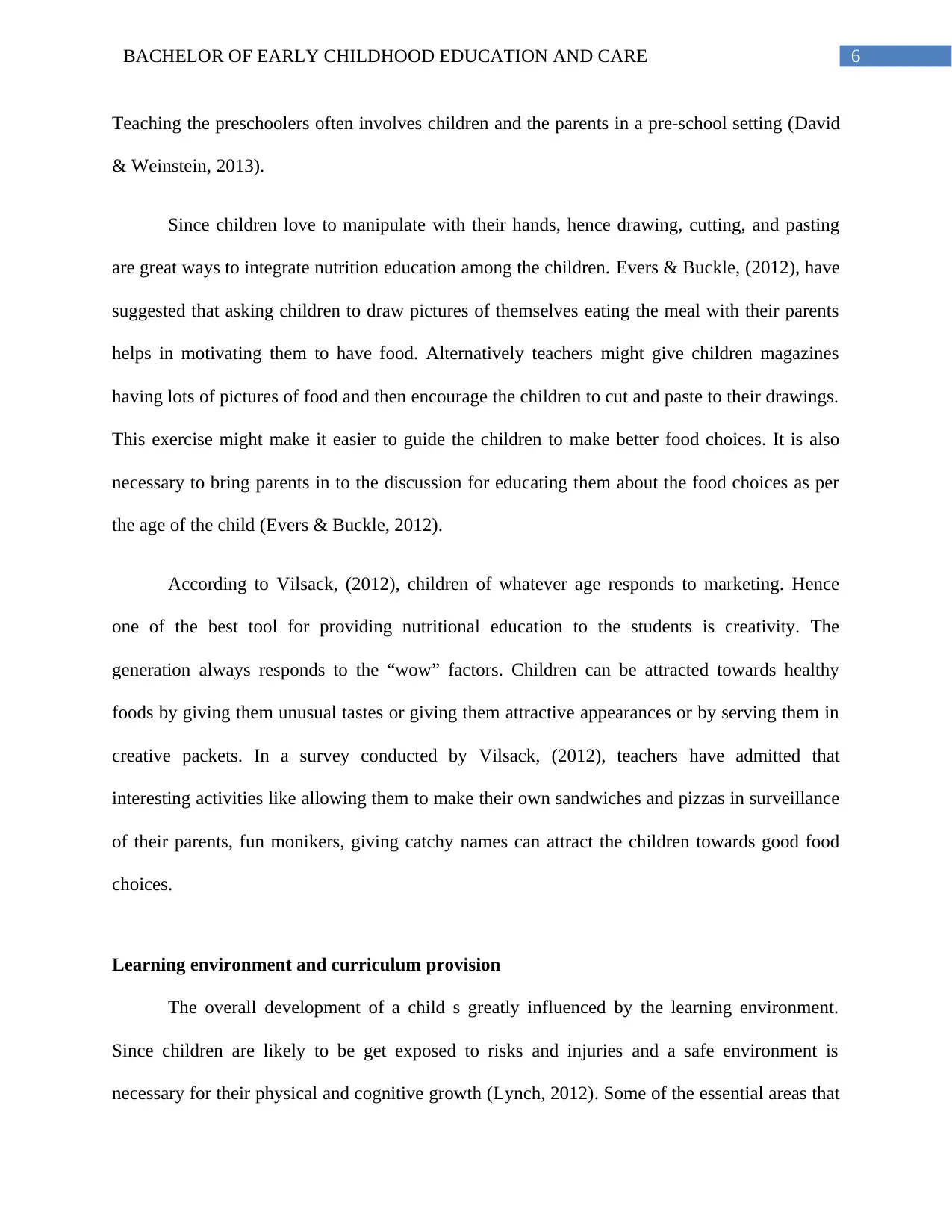
6BACHELOR OF EARLY CHILDHOOD EDUCATION AND CARE
Teaching the preschoolers often involves children and the parents in a pre-school setting (David
& Weinstein, 2013).
Since children love to manipulate with their hands, hence drawing, cutting, and pasting
are great ways to integrate nutrition education among the children. Evers & Buckle, (2012), have
suggested that asking children to draw pictures of themselves eating the meal with their parents
helps in motivating them to have food. Alternatively teachers might give children magazines
having lots of pictures of food and then encourage the children to cut and paste to their drawings.
This exercise might make it easier to guide the children to make better food choices. It is also
necessary to bring parents in to the discussion for educating them about the food choices as per
the age of the child (Evers & Buckle, 2012).
According to Vilsack, (2012), children of whatever age responds to marketing. Hence
one of the best tool for providing nutritional education to the students is creativity. The
generation always responds to the “wow” factors. Children can be attracted towards healthy
foods by giving them unusual tastes or giving them attractive appearances or by serving them in
creative packets. In a survey conducted by Vilsack, (2012), teachers have admitted that
interesting activities like allowing them to make their own sandwiches and pizzas in surveillance
of their parents, fun monikers, giving catchy names can attract the children towards good food
choices.
Learning environment and curriculum provision
The overall development of a child s greatly influenced by the learning environment.
Since children are likely to be get exposed to risks and injuries and a safe environment is
necessary for their physical and cognitive growth (Lynch, 2012). Some of the essential areas that
Teaching the preschoolers often involves children and the parents in a pre-school setting (David
& Weinstein, 2013).
Since children love to manipulate with their hands, hence drawing, cutting, and pasting
are great ways to integrate nutrition education among the children. Evers & Buckle, (2012), have
suggested that asking children to draw pictures of themselves eating the meal with their parents
helps in motivating them to have food. Alternatively teachers might give children magazines
having lots of pictures of food and then encourage the children to cut and paste to their drawings.
This exercise might make it easier to guide the children to make better food choices. It is also
necessary to bring parents in to the discussion for educating them about the food choices as per
the age of the child (Evers & Buckle, 2012).
According to Vilsack, (2012), children of whatever age responds to marketing. Hence
one of the best tool for providing nutritional education to the students is creativity. The
generation always responds to the “wow” factors. Children can be attracted towards healthy
foods by giving them unusual tastes or giving them attractive appearances or by serving them in
creative packets. In a survey conducted by Vilsack, (2012), teachers have admitted that
interesting activities like allowing them to make their own sandwiches and pizzas in surveillance
of their parents, fun monikers, giving catchy names can attract the children towards good food
choices.
Learning environment and curriculum provision
The overall development of a child s greatly influenced by the learning environment.
Since children are likely to be get exposed to risks and injuries and a safe environment is
necessary for their physical and cognitive growth (Lynch, 2012). Some of the essential areas that
Paraphrase This Document
Need a fresh take? Get an instant paraphrase of this document with our AI Paraphraser
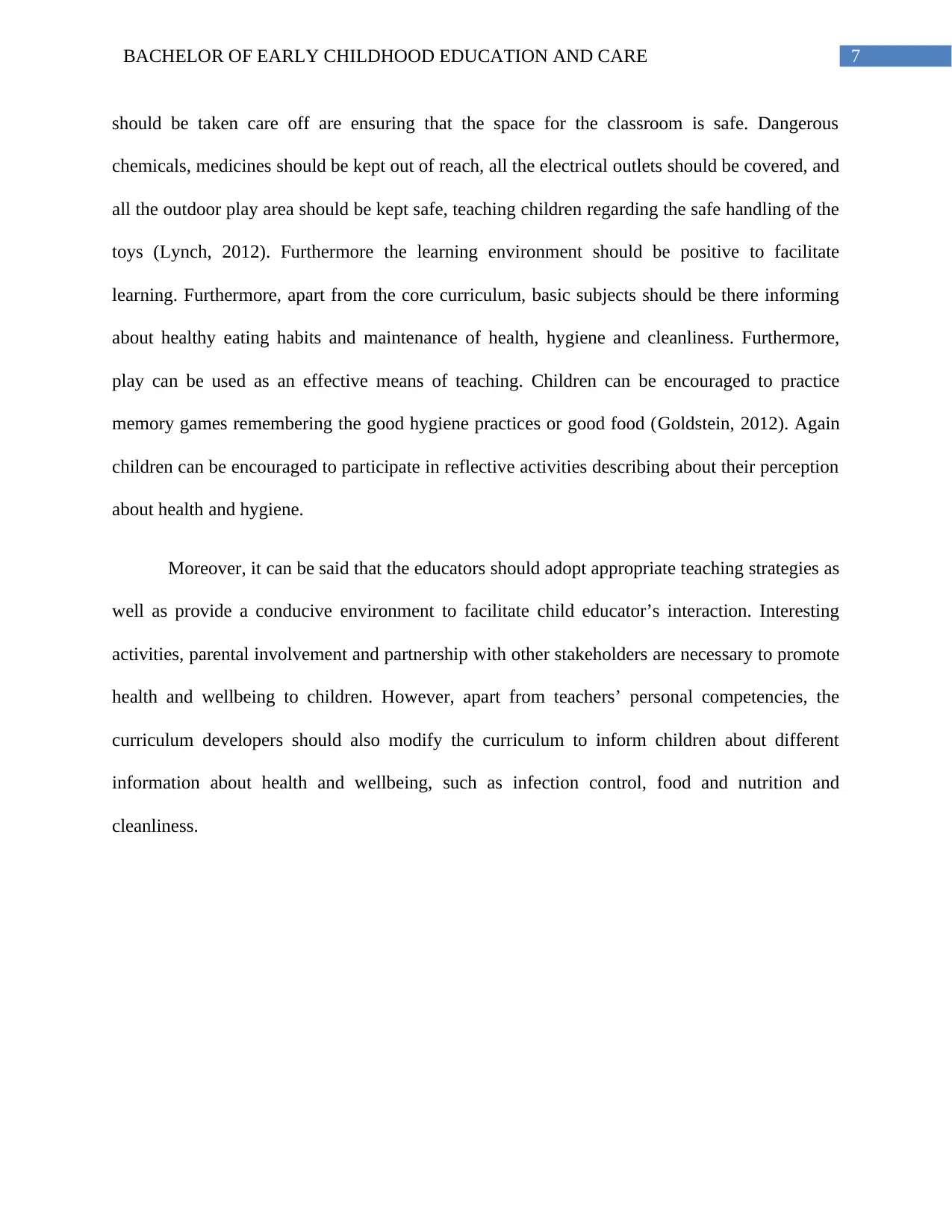
7BACHELOR OF EARLY CHILDHOOD EDUCATION AND CARE
should be taken care off are ensuring that the space for the classroom is safe. Dangerous
chemicals, medicines should be kept out of reach, all the electrical outlets should be covered, and
all the outdoor play area should be kept safe, teaching children regarding the safe handling of the
toys (Lynch, 2012). Furthermore the learning environment should be positive to facilitate
learning. Furthermore, apart from the core curriculum, basic subjects should be there informing
about healthy eating habits and maintenance of health, hygiene and cleanliness. Furthermore,
play can be used as an effective means of teaching. Children can be encouraged to practice
memory games remembering the good hygiene practices or good food (Goldstein, 2012). Again
children can be encouraged to participate in reflective activities describing about their perception
about health and hygiene.
Moreover, it can be said that the educators should adopt appropriate teaching strategies as
well as provide a conducive environment to facilitate child educator’s interaction. Interesting
activities, parental involvement and partnership with other stakeholders are necessary to promote
health and wellbeing to children. However, apart from teachers’ personal competencies, the
curriculum developers should also modify the curriculum to inform children about different
information about health and wellbeing, such as infection control, food and nutrition and
cleanliness.
should be taken care off are ensuring that the space for the classroom is safe. Dangerous
chemicals, medicines should be kept out of reach, all the electrical outlets should be covered, and
all the outdoor play area should be kept safe, teaching children regarding the safe handling of the
toys (Lynch, 2012). Furthermore the learning environment should be positive to facilitate
learning. Furthermore, apart from the core curriculum, basic subjects should be there informing
about healthy eating habits and maintenance of health, hygiene and cleanliness. Furthermore,
play can be used as an effective means of teaching. Children can be encouraged to practice
memory games remembering the good hygiene practices or good food (Goldstein, 2012). Again
children can be encouraged to participate in reflective activities describing about their perception
about health and hygiene.
Moreover, it can be said that the educators should adopt appropriate teaching strategies as
well as provide a conducive environment to facilitate child educator’s interaction. Interesting
activities, parental involvement and partnership with other stakeholders are necessary to promote
health and wellbeing to children. However, apart from teachers’ personal competencies, the
curriculum developers should also modify the curriculum to inform children about different
information about health and wellbeing, such as infection control, food and nutrition and
cleanliness.
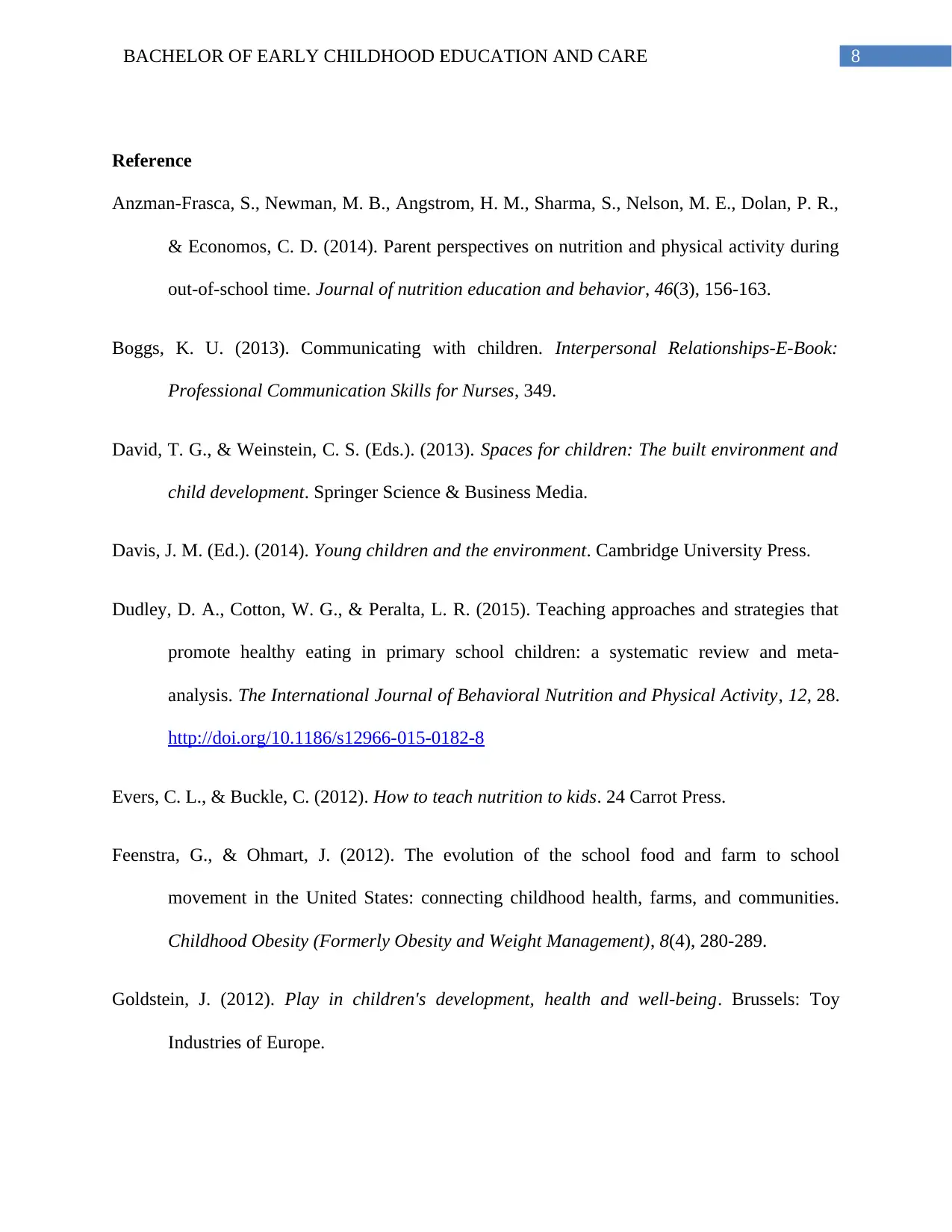
8BACHELOR OF EARLY CHILDHOOD EDUCATION AND CARE
Reference
Anzman-Frasca, S., Newman, M. B., Angstrom, H. M., Sharma, S., Nelson, M. E., Dolan, P. R.,
& Economos, C. D. (2014). Parent perspectives on nutrition and physical activity during
out-of-school time. Journal of nutrition education and behavior, 46(3), 156-163.
Boggs, K. U. (2013). Communicating with children. Interpersonal Relationships-E-Book:
Professional Communication Skills for Nurses, 349.
David, T. G., & Weinstein, C. S. (Eds.). (2013). Spaces for children: The built environment and
child development. Springer Science & Business Media.
Davis, J. M. (Ed.). (2014). Young children and the environment. Cambridge University Press.
Dudley, D. A., Cotton, W. G., & Peralta, L. R. (2015). Teaching approaches and strategies that
promote healthy eating in primary school children: a systematic review and meta-
analysis. The International Journal of Behavioral Nutrition and Physical Activity, 12, 28.
http://doi.org/10.1186/s12966-015-0182-8
Evers, C. L., & Buckle, C. (2012). How to teach nutrition to kids. 24 Carrot Press.
Feenstra, G., & Ohmart, J. (2012). The evolution of the school food and farm to school
movement in the United States: connecting childhood health, farms, and communities.
Childhood Obesity (Formerly Obesity and Weight Management), 8(4), 280-289.
Goldstein, J. (2012). Play in children's development, health and well-being. Brussels: Toy
Industries of Europe.
Reference
Anzman-Frasca, S., Newman, M. B., Angstrom, H. M., Sharma, S., Nelson, M. E., Dolan, P. R.,
& Economos, C. D. (2014). Parent perspectives on nutrition and physical activity during
out-of-school time. Journal of nutrition education and behavior, 46(3), 156-163.
Boggs, K. U. (2013). Communicating with children. Interpersonal Relationships-E-Book:
Professional Communication Skills for Nurses, 349.
David, T. G., & Weinstein, C. S. (Eds.). (2013). Spaces for children: The built environment and
child development. Springer Science & Business Media.
Davis, J. M. (Ed.). (2014). Young children and the environment. Cambridge University Press.
Dudley, D. A., Cotton, W. G., & Peralta, L. R. (2015). Teaching approaches and strategies that
promote healthy eating in primary school children: a systematic review and meta-
analysis. The International Journal of Behavioral Nutrition and Physical Activity, 12, 28.
http://doi.org/10.1186/s12966-015-0182-8
Evers, C. L., & Buckle, C. (2012). How to teach nutrition to kids. 24 Carrot Press.
Feenstra, G., & Ohmart, J. (2012). The evolution of the school food and farm to school
movement in the United States: connecting childhood health, farms, and communities.
Childhood Obesity (Formerly Obesity and Weight Management), 8(4), 280-289.
Goldstein, J. (2012). Play in children's development, health and well-being. Brussels: Toy
Industries of Europe.
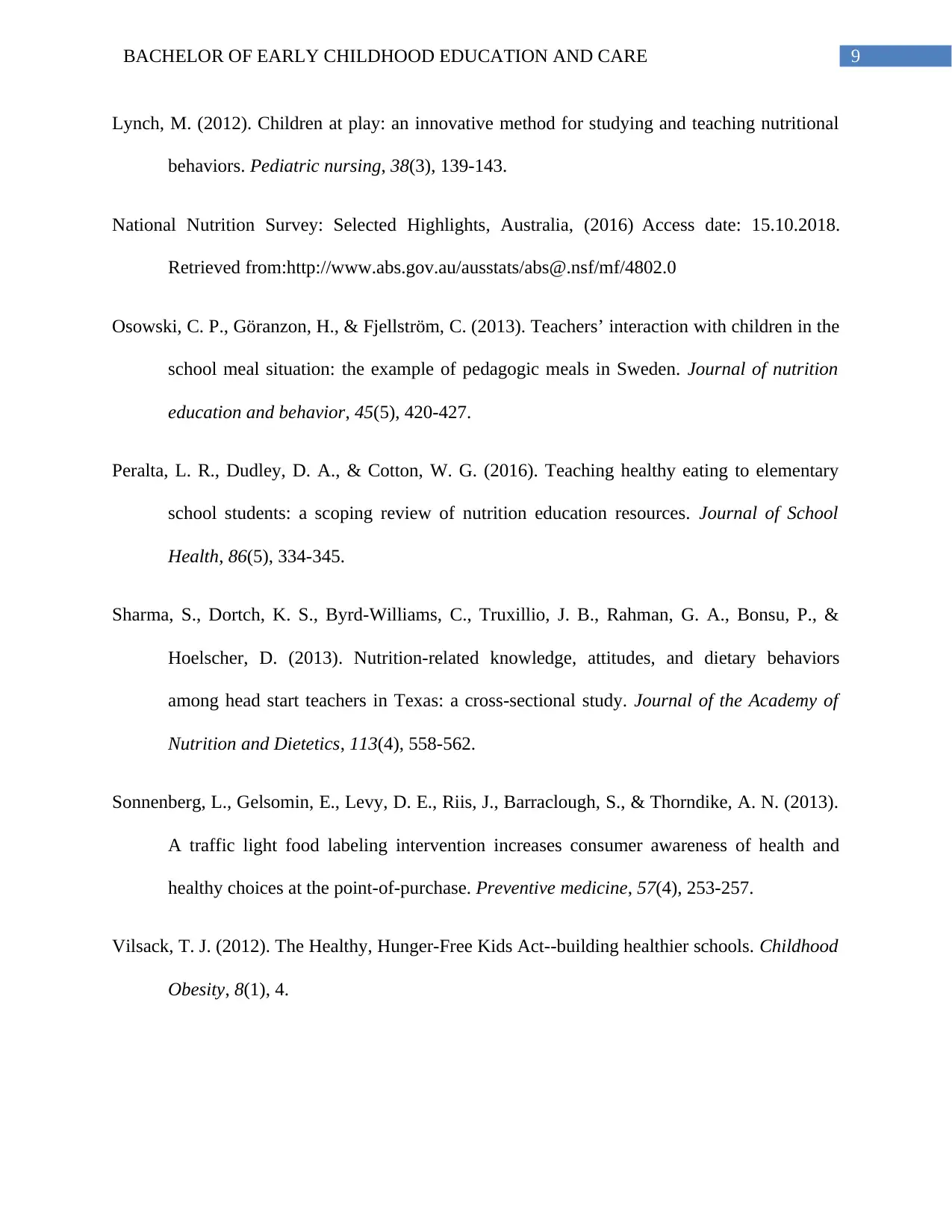
9BACHELOR OF EARLY CHILDHOOD EDUCATION AND CARE
Lynch, M. (2012). Children at play: an innovative method for studying and teaching nutritional
behaviors. Pediatric nursing, 38(3), 139-143.
National Nutrition Survey: Selected Highlights, Australia, (2016) Access date: 15.10.2018.
Retrieved from:http://www.abs.gov.au/ausstats/abs@.nsf/mf/4802.0
Osowski, C. P., Göranzon, H., & Fjellström, C. (2013). Teachers’ interaction with children in the
school meal situation: the example of pedagogic meals in Sweden. Journal of nutrition
education and behavior, 45(5), 420-427.
Peralta, L. R., Dudley, D. A., & Cotton, W. G. (2016). Teaching healthy eating to elementary
school students: a scoping review of nutrition education resources. Journal of School
Health, 86(5), 334-345.
Sharma, S., Dortch, K. S., Byrd-Williams, C., Truxillio, J. B., Rahman, G. A., Bonsu, P., &
Hoelscher, D. (2013). Nutrition-related knowledge, attitudes, and dietary behaviors
among head start teachers in Texas: a cross-sectional study. Journal of the Academy of
Nutrition and Dietetics, 113(4), 558-562.
Sonnenberg, L., Gelsomin, E., Levy, D. E., Riis, J., Barraclough, S., & Thorndike, A. N. (2013).
A traffic light food labeling intervention increases consumer awareness of health and
healthy choices at the point-of-purchase. Preventive medicine, 57(4), 253-257.
Vilsack, T. J. (2012). The Healthy, Hunger-Free Kids Act--building healthier schools. Childhood
Obesity, 8(1), 4.
Lynch, M. (2012). Children at play: an innovative method for studying and teaching nutritional
behaviors. Pediatric nursing, 38(3), 139-143.
National Nutrition Survey: Selected Highlights, Australia, (2016) Access date: 15.10.2018.
Retrieved from:http://www.abs.gov.au/ausstats/abs@.nsf/mf/4802.0
Osowski, C. P., Göranzon, H., & Fjellström, C. (2013). Teachers’ interaction with children in the
school meal situation: the example of pedagogic meals in Sweden. Journal of nutrition
education and behavior, 45(5), 420-427.
Peralta, L. R., Dudley, D. A., & Cotton, W. G. (2016). Teaching healthy eating to elementary
school students: a scoping review of nutrition education resources. Journal of School
Health, 86(5), 334-345.
Sharma, S., Dortch, K. S., Byrd-Williams, C., Truxillio, J. B., Rahman, G. A., Bonsu, P., &
Hoelscher, D. (2013). Nutrition-related knowledge, attitudes, and dietary behaviors
among head start teachers in Texas: a cross-sectional study. Journal of the Academy of
Nutrition and Dietetics, 113(4), 558-562.
Sonnenberg, L., Gelsomin, E., Levy, D. E., Riis, J., Barraclough, S., & Thorndike, A. N. (2013).
A traffic light food labeling intervention increases consumer awareness of health and
healthy choices at the point-of-purchase. Preventive medicine, 57(4), 253-257.
Vilsack, T. J. (2012). The Healthy, Hunger-Free Kids Act--building healthier schools. Childhood
Obesity, 8(1), 4.
1 out of 10
Related Documents
Your All-in-One AI-Powered Toolkit for Academic Success.
+13062052269
info@desklib.com
Available 24*7 on WhatsApp / Email
![[object Object]](/_next/static/media/star-bottom.7253800d.svg)
Unlock your academic potential
© 2024 | Zucol Services PVT LTD | All rights reserved.





